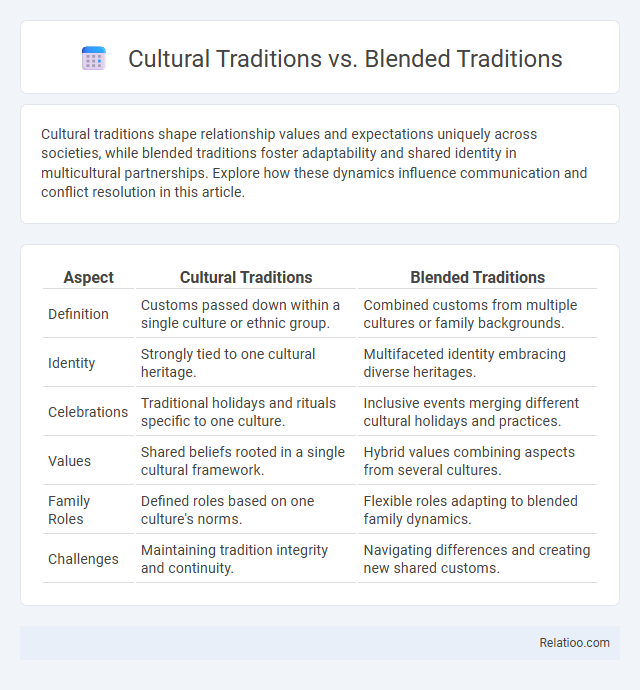Cultural traditions shape relationship values and expectations uniquely across societies, while blended traditions foster adaptability and shared identity in multicultural partnerships. Explore how these dynamics influence communication and conflict resolution in this article.
Table of Comparison
| Aspect | Cultural Traditions | Blended Traditions |
|---|---|---|
| Definition | Customs passed down within a single culture or ethnic group. | Combined customs from multiple cultures or family backgrounds. |
| Identity | Strongly tied to one cultural heritage. | Multifaceted identity embracing diverse heritages. |
| Celebrations | Traditional holidays and rituals specific to one culture. | Inclusive events merging different cultural holidays and practices. |
| Values | Shared beliefs rooted in a single cultural framework. | Hybrid values combining aspects from several cultures. |
| Family Roles | Defined roles based on one culture's norms. | Flexible roles adapting to blended family dynamics. |
| Challenges | Maintaining tradition integrity and continuity. | Navigating differences and creating new shared customs. |
Defining Cultural Traditions
Cultural traditions are established practices, customs, and beliefs passed down through generations within a particular community, shaping identity and social cohesion. These traditions encompass rituals, language, festivals, and art that reflect the collective heritage of a specific cultural group. Unlike blended traditions that merge elements from multiple cultures or family traditions centered around individual households, cultural traditions provide a broader societal framework rooted in shared history and values.
What Are Blended Traditions?
Blended traditions combine elements from different cultural, family, or religious backgrounds to create unique practices that reflect diverse heritages. These traditions often arise in multicultural families or communities, allowing You to honor multiple identities while fostering inclusivity and understanding. Unlike strictly cultural or single-family customs, blended traditions evolve over time, adapting rituals, celebrations, and values to fit the dynamic nature of modern life.
Historical Roots of Cultural Traditions
Cultural traditions originate from historical contexts deeply rooted in the collective experiences, beliefs, and practices of specific communities over centuries. Blended traditions emerge when distinct cultural customs merge through interactions such as migration, trade, or colonization, creating hybrid practices that reflect diverse heritages. Family traditions often represent personalized adaptations of broader cultural customs, passed down within generations, preserving historical roots while incorporating unique familial values.
The Evolution of Blended Traditions
Blended traditions emerge from the fusion of distinct cultural practices, creating a unique set of rituals that reflect the diversity of a family's heritage. This evolution often occurs as families merge different customs, adapting them to fit contemporary lifestyles while preserving core values and meanings. Your engagement in these evolving blended traditions fosters deeper connections and promotes cultural understanding across generations.
Factors Influencing Traditional Practices
Cultural traditions are deeply rooted in shared history, language, and collective values, shaped by geographic and religious influences that preserve distinct community identities. Blended traditions emerge from the convergence of multiple cultural backgrounds, often influenced by migration, globalization, and intercultural exchange, resulting in hybrid customs that adapt over time. Family traditions are primarily influenced by generational transmission, personal beliefs, and individual experiences, creating unique practices within the broader cultural or blended context.
How Blended Traditions Emerge
Blended traditions emerge through the fusion of diverse cultural practices as families adapt to multicultural environments, fostering new rituals that honor multiple heritages. This evolution often occurs in immigrant communities where preserving ancestral customs integrates with local influences, creating unique, hybrid celebrations. The dynamic nature of blended traditions strengthens family identity by combining values and customs from different backgrounds into cohesive, meaningful observances.
Benefits of Preserving Cultural Traditions
Preserving cultural traditions strengthens community identity by maintaining unique customs, languages, and rituals passed down through generations. It fosters a sense of belonging and continuity, promoting social cohesion and respect for heritage across diverse groups. These traditions also enrich personal and collective experiences, providing valuable lessons and a foundation for cultural pride.
The Impact of Blended Traditions on Society
Blended traditions create a unique cultural tapestry by merging customs from diverse ethnic and familial backgrounds, fostering inclusivity and mutual respect within communities. This fusion enhances social cohesion and encourages innovation in cultural expressions, reflecting the evolving identities of modern societies. The dynamic nature of blended traditions supports the preservation of heritage while simultaneously adapting to contemporary social values and global interconnectedness.
Challenges and Controversies
Cultural traditions often face challenges when integrated into blended traditions, as differing customs and values can lead to conflicts and misunderstandings within families. Family traditions may struggle to maintain authenticity amid evolving social norms and intercultural influences that blur distinct cultural identities. Controversies arise when preservation of heritage clashes with adaptation, raising questions about which practices to sustain or modify.
The Future: Integration or Preservation?
Cultural traditions emphasize preserving historical customs unique to specific communities, while blended traditions merge elements from diverse cultures to create new, dynamic practices. Family traditions serve as intimate, personalized expressions of cultural heritage, often adapting over generations. The future of these traditions hinges on balancing integration, which fosters inclusivity and innovation, with preservation, ensuring the continuity of cultural identity and ancestral values.

Infographic: Cultural Traditions vs Blended Traditions
 relatioo.com
relatioo.com